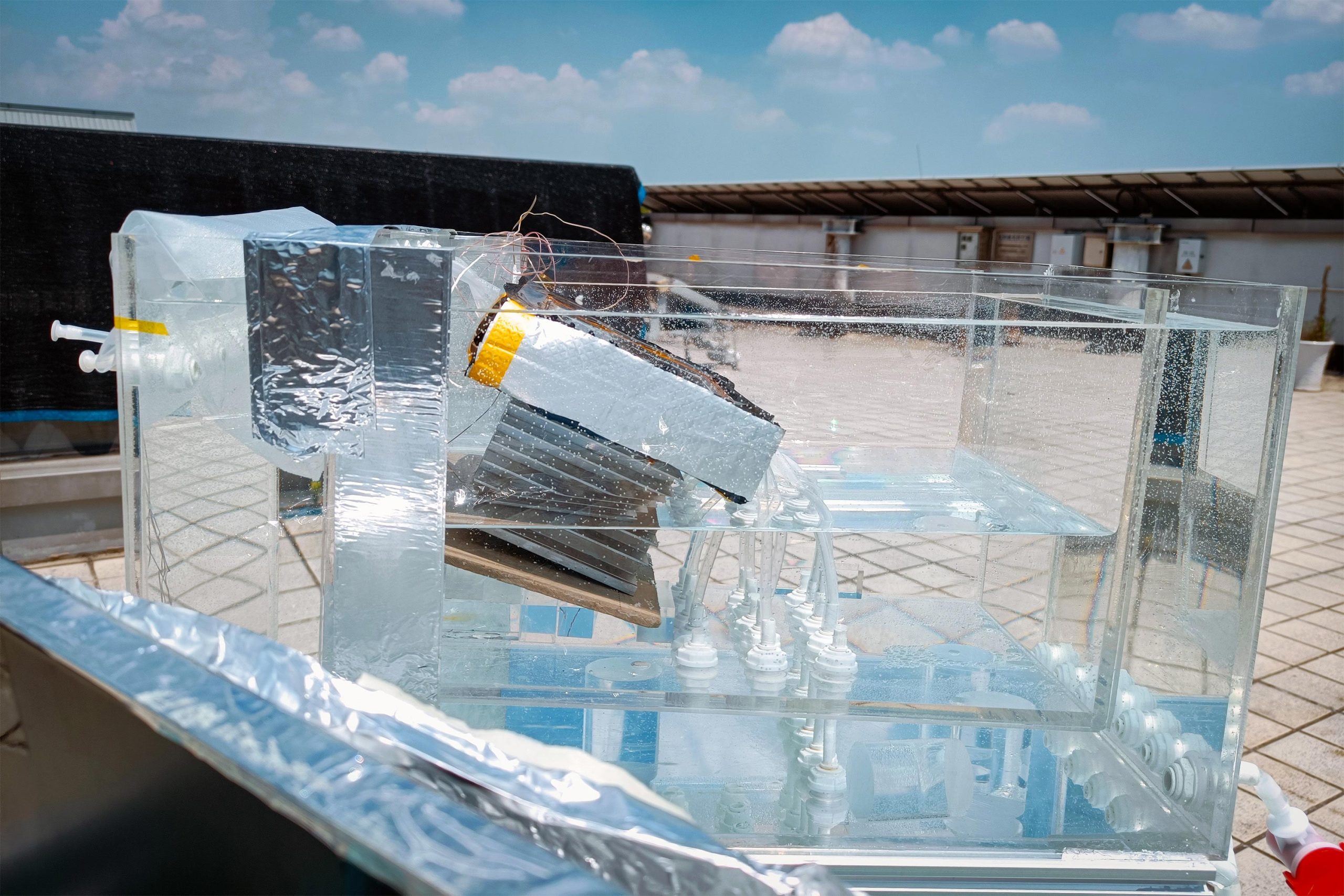Annnnd we’ll never see it ever again
Honestly this is why I never pay any attention to “uplifting news” communities as it ultimately gets your hopes up for nothing. The bi monthly “revolutionary cure” for cancer is getting pretty damn old too.
China
If they can get it, they will build it. There’s already water scarcity on some regions there. No way it will go back into oblivion.
its the second time i see this one
The main problem I always hear with this is “where does the brine go?”
It can’t easily be dumped without causing ecological chaos. In the water it can kill ocean life. On land it can make plant life never grow again in certain areas, also leeching into groundwater.
I love this technology buy am apprehensive about its deployment.
Sell it as edible salt.
This is the actual answer - you put this in evap fields with no run-off potential (so as not to harm fresh or salt water environments), dry your slurry through stages and then sell the salts commercially for further refinement and consumption.
Total US salt production is roughly 40 million metric tons (or 40 billion kg) per year.
Let’s say we use this process to desalinate water for just 10% LA County’s water needs. LA County currently uses 1.5mm acre-feet of water per year. In SI units, this is about 2 trillion liters each year.
There’s about 35g of salt in each liter of seawater.
So… at just 10%, we’re desalinating about 200 billion liters a year and producing 7 million tons of salt.
If we desalinate for the rest of the state, or the rest of the Southwest, we’ll easily be producing more salt each year than all of the mining activity nationwide.
At some point the excess salt will have no buyers, and we will still need to deal with it.
I’m a fan of the simpler approach: Build long-ass pipes out into the ocean, and slowly dilute the brine so that it’s not concentrated in any one spot. The total salinity of the entire ocean will not change by any perceptible amount, so long as you don’t drop heavy brine in any one spot.
Sorry, forgot to add sources:
Those are going to be some long as spipes indeed if you want to pump brine out without salt spots.
quite true, although we already have long ass pipes/cables in the ocean for phone/internet connections between continents. So it’s entirely doable, and is already being done for another purpose besides salt.
Yeah. It may be “simple” but it’s not going to be cheap. I still think it’ll be cheaper than dedicating huge swaths of coastal land to become brine-drying fields, though.
I’m pretty sure we can find more uses for ocean salt. At the amounts we’re talking about people will find uses for it. One of the things people tend to ignore is that ocean water contains a lot more than just salt. It also contains metals and organic compounds. Looking over the Wikipedia article there is a significant component of magnesium, sulpher, calcium, potassium, and bromine. There are even industries devoted to extracting sodium, magnesium, potassium, and calcium from sea water. If we substantially increase the desalination of sea water we could significantly reduce the cost of extracting them. With the amount of brine you’re talking about it would pretty much be free to anyone who could find a use for it, since the alternative is diluting it and pumping it back into the ocean, which is pure cost. At that scale you could likely also extract trace components in significant quantities. The page mentions lithium and uranium were attempted in the past, with uranium never seeing industrial scale due to it being too expensive, but economies of scale and all that.
It could be used in molten-salt batteries, however I’m not sure of how efficient the technology is.
Under capitalism they’d not buy the excess because they want to keep the price up but this is a good path towards post scarcity with salt
Capitalism: purchase a snack food conglomerate, lobby to remove sodium from food labels, increase salt in snack foods dramatically, and sell at a loss; this will drive up demand for the desalinated water.
Edit: add HFCS to the food and sell it at a massive profit.
Like how some places get salt. Put it in a pool and let it evaporate in the sun
Put it in empty oil tankers and have them disperse it through the ocean. Might have to retrofit them to put a port that leads to the ocean but besides that should be pretty cheap. No reason that empty tanker heading back to Saudi Arabia can’t be filled with brine.
That would likely make it much more expensive than tap water, rendering the device almost pointless except in cases where they probably couldn’t afford it anyways.
Not an expert here but the word that comes screaming into my head seeing that is ‘rust’. Would the brine be easier to deal with solidified into salt? Even edible?.
I wonder if we could evaporate to extract salt and recover water from the brine once any harmful products are filtered out of the brine
the design for a new solar desalination system that takes in saltwater and heats it with natural sunlight.
The configuration of the device allows water to circulate in swirling eddies, in a manner similar to the much larger “thermohaline” circulation of the ocean. This circulation, combined with the sun’s heat, drives water to evaporate, leaving salt behind. The resulting water vapor can then be condensed and collected as pure, drinkable water. In the meantime, the leftover salt continues to circulate through and out of the device, rather than accumulating and clogging the system.
Neat.
The team envisions a scaled-up device could passively produce enough drinking water to meet the daily requirements of a small family.
Hmm.
The last paragraph is cool too though. A single device for a household that produces enough water would be big for many communities. The only real question here is how complex and expensive the device is.
I wonder whether that’s safe enough considered there much shit in salty water than just salt but judging by the fact it’s condensing I guess that’d mean yes?
Most of the shit will remain down with the salt, as they’re too dense to flow upwards with the water vapor.
Btw, that’s pretty much distilled water, right? While drinkable, it’ll be lacking some needed minerals, no?
No. You can get those minerals from your food. It is safe to drink distilled water. But there is a lot of misinformation about distilled water, I have even had people tell me it can kill them! Water is water. Get your minerals from food.
Tbf, chugging over a gallon of distilled water in one go will actually kill you though
Better than chugging a gallon of artificial sweetener, caffiene and flavours.
Isn’t a gallon almost four litres? A gallon of anything is going to be dangerous to drink all at once.
Isn’t a gallon almost four litres? A gallon of anything is going to be dangerous to drink all at once.
That’s the joke
Good to know, I had the misconception that you could only get some never specified minerals from freshwater and that distilled water would leave you mostly thirsty.
Likely from some company trying to sell expensive foul tasting “sports water”. Eat a bag of crisps with your water if you are really concerned about your salt intake.
Drinking distilled water will not leave you thirsty. And on a study here in Australia on teenagers drinking electrolyte sport drink vs water while doing athletics, it was proven there was better athletic performance from the water drinkers… Which brings a lot of the advertising into question.
Sorry, what study exactly?
Electrolyte (e.g. Potassium) replacement during intense exercise is essential. That’s why every athlete nowadays uses it.
Brawndo’s got what humans crave. It’s got electrolytes!
It’s literally distilled water. I don’t know what this technology does that other evaporative distillation systems don’t already do, besides being solar powered.
Other stuff should be limited since the water evaporates and is then condensed. Little should be carried with it, but I don’t know for certain.
“The researchers estimate that if the system is scaled up to the size of a small suitcase, it could produce about 4 to 6 liters of drinking water per hour and last several years before requiring replacement parts.”
Is this really that early in the research or is there some other barrier to testing that in the near future, as in if it were that practical why didn’t they do it already?
Maybe funding. Get a grant of $10,000 and you can only build something so big.
Use that to prove it’s a viable idea that could work and go searching for a $100,000 grant to make a bigger real-use one and make refinements to then use to search for investors that can start manufacturing.
Well what are you waiting for? Give em 100k. Geeze.
Here’s a hint: What to do with all the fuckin waste products??
That’s the same issue as now.
People are paying good money for sea salt all the time in grocery stores.
https://doi.org/10.1016/j.joule.2023.08.012 link to the journal article
The trick is thermohaline circulation, basically salty water moves differently then fresh water in cold and warm environments. So to promote that effect the stage is tilted to allow warmer fresh water above cooler salty water below. Then a membrane moves the salt out of the circulation so as not to accumulate and clog the system.
The thing is that scaling this upward would present some challenges structurally to do large volumes OR the complexity would increase if they kept the same size and just made thousands of these little stages. Not to mention that, depending on what they’re using for a membrane for salt removal, having a larger surface area could make it easier or more difficult to maintain. Easier in that you only need to clean it every so often (the membrane helps spread the load) or more difficult in that such a large membrane requires delicate processes to change out.
Also commercial production requires a fixed output, so with sunlight being variable any commercial installation would require storage.
But reading the brine discharge always makes me wish that grid based sodium ion batteries would be researched more. But can’t have that because oil companies already put large deposits into lithium mines.
But reading the brine discharge always makes me wish that grid based sodium ion batteries would be researched more. But can’t have that because oil companies already put large deposits into lithium mines.
Its light on specifics but China is already producing Sodium batteries which makes sense for a nation that is technologically advanced, but resource poor. Since China doesn’t have any entrenched petroleum interests, and is geopolitically distant to most of the proven cobalt and lithium supplies, it makes sense for them to use what they have plenty of.
Honestly, I’m excited about this. Sodium batteries aren’t very energy dense, but they should be very cheap. Lots of applications don’t need physically small batteries (like grid or solar tied).
Get this shit to North Africa on the double!
What do they do with the waste tho
aren’t we looking for salt in winter to spread on roads? There’re mining here for this purpose, I don’t think salt would be a waste, if we’re talking about salt and I’m not missing something else. Because I don’t read those articles don’t want to get hope with a new revolutionary device until I see them in use.
I guess those news exist because scientists have hard time getting funds, so they have to sell miracle in hope to continue their researchs
Automatically rejecting the salt is huge!
you meant to say “tight!”
Sure! Something positive to point out how great that feature is.
Learning new vocabulary is tight!
wow wow wow wow… wow
MIT Desalination System Prototype A tilted ten-stage solar-powered prototype desalination device is located in a “boat-like” reservoir. It efficiently turns seawater into drinkable water, potentially at costs lower than tap water production. Credit: Jintong Gao and Zhenyuan Xu
MIT engineers and collaborators developed a solar-powered device that avoids the salt-clogging issues of other designs.
Engineers at MIT and in China are aiming to turn seawater into drinking water with a completely passive device that is inspired by the ocean, and powered by the sun.
In a paper published on September 27 in the journal Joule, the research team outlines the design for a new solar desalination system that takes in saltwater and heats it with natural sunlight.
The configuration of the device allows water to circulate in swirling eddies, in a manner similar to the much larger “thermohaline” circulation of the ocean. This circulation, combined with the sun’s heat, drives water to evaporate, leaving salt behind. The resulting water vapor can then be condensed and collected as pure, drinkable water. In the meantime, the leftover salt continues to circulate through and out of the device, rather than accumulating and clogging the system.
Enhanced Efficiency and Performance The new system has a higher water-production rate and a higher salt-rejection rate than all other passive solar desalination concepts currently being tested.
The researchers estimate that if the system is scaled up to the size of a small suitcase, it could produce about 4 to 6 liters of drinking water per hour and last several years before requiring replacement parts. At this scale and performance, the system could produce drinking water at a rate and price that is cheaper than tap water.
“For the first time, it is possible for water, produced by sunlight, to be even cheaper than tap water,” says Lenan Zhang, a research scientist in MIT’s Device Research Laboratory.
Prototype MIT Desalination System Outdoor test of the prototype solar-powered desalination device that can convert seawater into potable water under natural sunlight. Credit: Jintong Gao and Zhenyuan Xu
The team envisions a scaled-up device could passively produce enough drinking water to meet the daily requirements of a small family. The system could also supply off-grid, coastal communities where seawater is easily accessible.
Zhang’s study co-authors include MIT graduate student Yang Zhong and Evelyn Wang, the Ford Professor of Engineering, along with Jintong Gao, Jinfang You, Zhanyu Ye, Ruzhu Wang, and Zhenyuan Xu of Shanghai Jiao Tong University in China.
Evolution of the Design The team’s new system improves on their previous design — a similar concept of multiple layers, called stages. Each stage contained an evaporator and a condenser that used heat from the sun to passively separate salt from incoming water. That design, which the team tested on the roof of an MIT building, efficiently converted the sun’s energy to evaporate water, which was then condensed into drinkable water. But the salt that was left over quickly accumulated as crystals that clogged the system after a few days. In a real-world setting, a user would have to place stages on a frequent basis, which would significantly increase the system’s overall cost.
In a follow-up effort, they devised a solution with a similar layered configuration, this time with an added feature that helped to circulate the incoming water as well as any leftover salt. While this design prevented salt from settling and accumulating on the device, it desalinated water at a relatively low rate.
In the latest iteration, the team believes it has landed on a design that achieves both a high water-production rate, and high salt rejection, meaning that the system can quickly and reliably produce drinking water for an extended period. The key to their new design is a combination of their two previous concepts: a multistage system of evaporators and condensers, that is also configured to boost the circulation of water — and salt — within each stage.
“We introduce now an even more powerful convection, that is similar to what we typically see in the ocean, at kilometer-long scales,” Xu says.
The small circulations generated in the team’s new system is similar to the “thermohaline” convection in the ocean — a phenomenon that drives the movement of water around the world, based on differences in sea temperature (“thermo”) and salinity (“haline”).
“When seawater is exposed to air, sunlight drives water to evaporate. Once water leaves the surface, salt remains. And the higher the salt concentration, the denser the liquid, and this heavier water wants to flow downward,” Zhang explains. “By mimicking this kilometer-wide phenomena in small box, we can take advantage of this feature to reject salt.”
System Mechanics The heart of the team’s new design is a single stage that resembles a thin box, topped with a dark material that efficiently absorbs the heat of the sun. Inside, the box is separated into a top and bottom section. Water can flow through the top half, where the ceiling is lined with an evaporator layer that uses the sun’s heat to warm up and evaporate any water in direct contact. The water vapor is then funneled to the bottom half of the box, where a condensing layer air-cools the vapor into salt-free, drinkable liquid. The researchers set the entire box at a tilt within a larger, empty vessel, then attached a tube from the top half of the box down through the bottom of the vessel, and floated the vessel in saltwater.
In this configuration, water can naturally push up through the tube and into the box, where the tilt of the box, combined with the thermal energy from the sun, induces the water to swirl as it flows through. The small eddies help to bring water in contact with the upper evaporating layer while keeping salt circulating, rather than settling and clogging.
The team built several prototypes, with one, three, and 10 stages, and tested their performance in water of varying salinity, including natural seawater and water that was seven times saltier.
From these tests, the researchers calculated that if each stage were scaled up to a square meter, it would produce up to 5 liters of drinking water per hour, and that the system could desalinate water without accumulating salt for several years. Given this extended lifetime, and the fact that the system is entirely passive, requiring no electricity to run, the team estimates that the overall cost of running the system would be cheaper than what it costs to produce tap water in the United States.
“We show that this device is capable of achieving a long lifetime,” Zhong says. “That means that, for the first time, it is possible for drinking water produced by sunlight to be cheaper than tap water. This opens up the possibility for solar desalination to address real-world problems.”
“This is a very innovative approach that effectively mitigates key challenges in the field of desalination,” says Guihua Yu, who develops sustainable water and energy storage systems at the University of Texas at Austin, and was not involved in the research. “The design is particularly beneficial for regions struggling with high-salinity water. Its modular design makes it highly suitable for household water production, allowing for scalability and adaptability to meet individual needs.”
Reference: “Extreme salt-resisting multistage solar distillation with thermohaline convection” by Jintong Gao, Lenan Zhang, Jinfang You, Zhanyu Ye, Yang Zhong, Ruzhu Wang, Evelyn N. Wang and Zhenyuan Xu, 27 September 2023, Joule. DOI: 10.1016/j.joule.2023.08.012
10 COMMENTS stephen schaffer | October 3, 2023 at 8:43 am | Reply Thank goodness for plastic.
Tom Casper | October 4, 2023 at 6:11 am | Reply What happens to the salt?
A | October 5, 2023 at 5:09 am | Reply As if salt is the only issue with sea water…
Bryce k | October 5, 2023 at 7:50 am | Reply Actually it is. Salt in sea water is more or less the only thing we aren’t capable of filtering out cheaply and efficiently through traditional methods.
SuperiorDave | October 5, 2023 at 7:26 am | Reply Men in black have entered the chat.
Morgan | October 5, 2023 at 2:27 pm | Reply they built a solar distill? i built one of these in elementary school in the 80s. great job everybody?
California Dreamer | October 5, 2023 at 8:39 pm | Reply Sounds promising. However, it would be helpful to know how the seawater will be filtered and pumped to the desalination unit. They can’t draw in unfiltered seawater without clogging the intake with seaweed and other natural debris. Also, there is no discussion on toxins or other pollution. Seawater near shorelines in most parts of the urban world are polluted by untreated effluent or raw sewage, and often worse industrial chemicals. Still, it is a fantastic first step, but before these can be safely used, source water and denomination will be required.
Seja | October 5, 2023 at 11:29 pm | Reply All valid points, but they all can be addressed now and relatively cheaply. Like Bryce said – this is the only thing we haven’t done well. Debris – can have a number filter around. Toxins and heavy metals – another layer of filter we already have at mass scale. Even if you add more treatments it’s still cheaper than current energy intensive desalination. This is exciting new thing development that sadly will come with delays because of greed.
NameThatBillionaire | October 5, 2023 at 10:24 pm | Reply Perfect for billionairs on their yachts with years worth of food stored (they can also fish) while the world falls apart.
John S | October 6, 2023 at 9:06 am | Reply How well does it perform under cloudy skies?
Makes sense that you’d be on the lemmygrad instance.

















